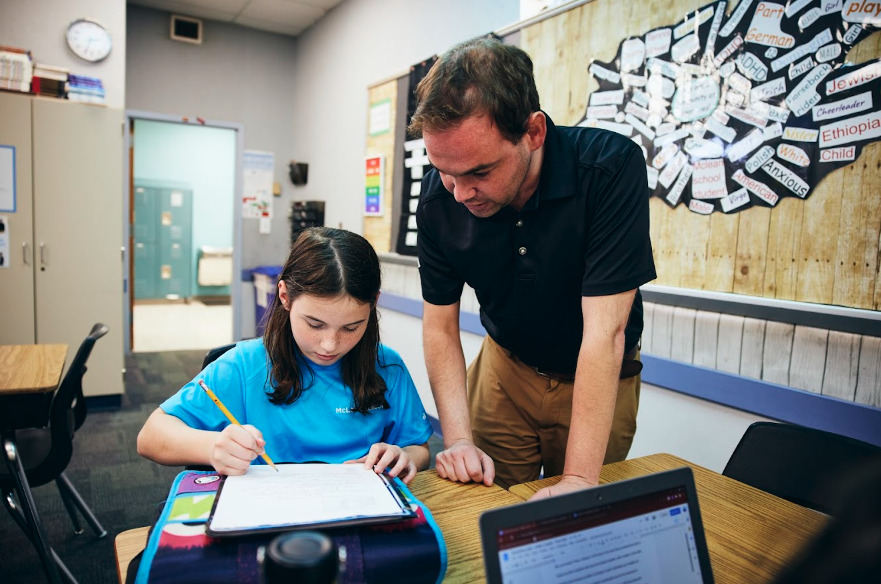David Roth, Assistant Head of School
for Educational Programs
Head of Middle School
Chapin Miller, Head of Upper School
The Value of Struggle: This is Where the Learning Happens

If it doesn’t challenge you, it doesn’t change you. With pain comes progress. What doesn’t kill you makes you stronger. Cliches about the upsides of adversity abound, and with good reason: struggling is a natural part of life and vital to our growth and development. It can also be uncomfortable for children and parents alike! As educators, we believe there is value in struggle for all of our students, from our littlest learners in Lower School to the young adults in our Upper School—and we also believe in providing the right skills and supports to help them get through it, and grow without being overwhelmed.
McLean’s educational leaders agree: when we swoop in and spare students from struggle, we rob them of the chance to tap into their own perseverance and problem-solving skills. Making mistakes, grappling with issues and concepts, sitting with discomfort and tolerating frustration, to be patient with oneself and others . . this is where the learning happens and how you develop a growth mindset.
The ingredients for a “successful struggle” are baked into our School, with an emphasis on trusting relationships, our small classes, an educational approach that sees and responds to each learner, including the fact that academics and social-emotional learning are intertwined. “McLean is really good at finding the right balance, knowing when and how much to push,” says David Roth, Assistant Head of School for Educational Programs and Head of Middle School. “As a result, our students develop the confidence and capacity for reasonable risk taking knowing that they will be supported through it.” Better still, they learn to find the right balance for themselves.
“That safety net is really important,” says Head of Upper School, Chip Miller. “You aren’t going to get people to try new things if they don’t believe it’s going to be relatively okay. But it’s also something that has to be well managed. We want our students to know the net is there, but out of view enough for them to be self-reliant, to believe in themselves, and take a leap of faith.”
Much like the toddler who turns to their parents for cues about how to react when they stumble, our students are looking to us to normalize missteps and setbacks and risk taking, and to model resilience in our response. To be expected, the supports look different depending on age and stage, but the goal is always to build resilience and appreciation for challenges and strengths. In the Lower School, for example, teachers will often work with students on self-talk strategies, narrating thoughts such as “this is really hard but I’m learning” or “I haven’t figured it out – yet.” Jjust as important as creating opportunities to wrestle with what’s hard is allowing for the unloading that often goes along with it. It’s not always smooth and easy, and as educators, and parents, it’s important to make space for that. It’s an inevitable and equally valuable part of the process.”
As children mature, certain realities present and we are well-prepared to help our students process them. “Middle School is usually the time when students come into awareness that they aren’t good at everything,” says David Roth. “You aren’t always rewarded for showing up, you also need to demonstrate skill or work ethic. Letter grades are introduced. Maybe you don’t get an A, or make the top team, but you still get a great teacher or coach and learning experience. And by the time you face the greater challenges of high school and beyond, you’ve successfully navigated enough situations to know, okay, this happens and I can get through it.”
“At McLean, our students are among the most resilient I’ve ever seen,” says Chip. “And they’re extraordinary in part because life wasn’t always so easy. The nice thing for us is that we get to show them that you aren’t limited by challenges, in fact they can make you even more successful.”
Some prospective parents worry that their children won’t be able to meet the challenges and others worry that theirs won’t be challenged enough, says Chip Miller. “I think it’s okay for school to be hard, sometimes really hard, in fact we want it to be hard. But it’s not okay for it to be impossible,” he says. “School should never make students feel bad about themselves. We’re just going to help them realize they can do a lot more than they thought they could.”
The system works. Our students come back to us from college and their professional lives and tell us that they are better for the struggle. The Abilities Model® certainly plays a role in that process. They may come in identifying with their challenges but they leave with a greater appreciation for their strengths.”
– By David Roth, Assistant Head of School for Educational Programs and Head of Middle School, and Chapin Miller, Head of Upper School